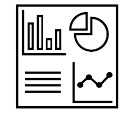
Many companies use mechanizations and robotics for eliminating human efforts and improving reliability and consistency of the process. Most pharmaceutical manufacturing equipment today are capable to run with recipes and have data acquisition systems. They capture lot more data than those controlled through batch records as Critical Process Parameters (CPPs).
The Power of Analytical Dashboards
 Simple way of using data is creating Analytical dashboards which can give useful information without having to go through piles of data scattered over various systems. Analytical dashboards can be designed to provide meaningful information about Key Performance indicators, health of the processes and quality systems etc. using all the available data across various systems mentioned earlier.
Simple way of using data is creating Analytical dashboards which can give useful information without having to go through piles of data scattered over various systems. Analytical dashboards can be designed to provide meaningful information about Key Performance indicators, health of the processes and quality systems etc. using all the available data across various systems mentioned earlier.
These dashboards can help managers in daily management, to take necessary course corrections when required. The dashboards can also help in identifying improvement opportunities. AI tools can be used to perform multivariate analysis and establish relationships between, Critical Material Attributes (CMAs), CPPs and Critical Quality Attributes (CQAs) which were not established during product and process development. These tools can be designed to identify the golden tunnel to run the processes to give best performance with respect to quality attributes as well as yields.
Information gathered from manufacturing operations like that mentioned earlier can be leveraged by R&D for optimal process development for new products. Other information available in R&D related to past products including drug- excipient interactions, degradation pathways, structure activity relationships, stability data, bioavailability data, dissolution profiles etc can be mined using AI tools to get first time right development there by reducing the development cycle time.
Investigation of non-conformities
 It is yet another area in the Pharmaceuticals which often takes a long time and huge resources due to difficulty in gathering relevant data from the batch records and its analysis. Also, sometimes analysis of the data available in the batch records do not lead to identification of the root cause because many time the failures could be due to multivariate effect and sometimes even those parameters have impact which have not been earlier identified as CPPs. Having huge amount of data of CMAs, process parameters, machine parameters, environmental parameters etc and ability to do meaningful analysis of such data in short time can help in establishing correlations which might have not been understood in the past.
It is yet another area in the Pharmaceuticals which often takes a long time and huge resources due to difficulty in gathering relevant data from the batch records and its analysis. Also, sometimes analysis of the data available in the batch records do not lead to identification of the root cause because many time the failures could be due to multivariate effect and sometimes even those parameters have impact which have not been earlier identified as CPPs. Having huge amount of data of CMAs, process parameters, machine parameters, environmental parameters etc and ability to do meaningful analysis of such data in short time can help in establishing correlations which might have not been understood in the past.
Out of Specification results especially those due to laboratory failures is another pain point in the industry. Data analysis of system suitability parameters and other parameters of chromatography analysis on continual basis can be used to predict the systems or column failures in advance, so that OOS or OOT results which can be caused by these can be avoided by taking appropriate measures.
Use of other new technologies in operations
 Process analytical Technology has been talked about for long time but is still not being widely deployed in the industry. There are lot of sensor available today which can give us important information about the process. PAT tools along with continuous manufacturing technologies can bring significant efficiency in Pharmaceutical operations by way of reduced footprint, less material handling, lower storage space and energy consumption.
Process analytical Technology has been talked about for long time but is still not being widely deployed in the industry. There are lot of sensor available today which can give us important information about the process. PAT tools along with continuous manufacturing technologies can bring significant efficiency in Pharmaceutical operations by way of reduced footprint, less material handling, lower storage space and energy consumption.
Many IoT sensors are now available for continuously monitoring parameters like temperature, vibrations etc. This data can be analysed using AI tools for predictive maintenance of the equipment thereby minimising breakdowns and improving OEE.

AR & VR technologies can be used to guide operators in flawless execution and also for training of new employees.
